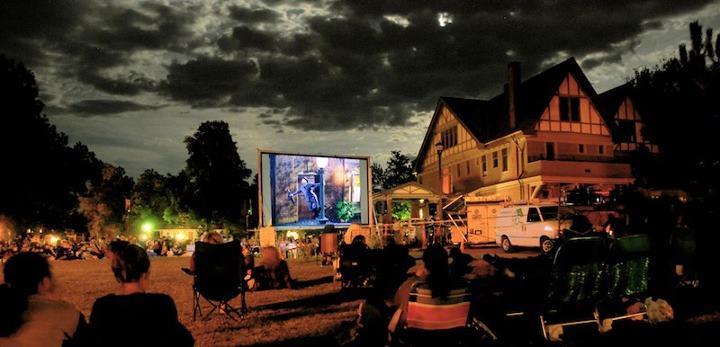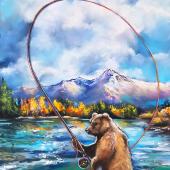Film in Bozeman
A brief history of Montana's film industry.
Indelibly bound with the spirit of independence and fortitude that permeates the idea of the West is a notion of single-minded, almost blind acceptance of certain dogmata. After all, how exactly does one get motivated to cross thousands of miles of terrain, with absolutely no particular place in mind except for what the imagination has created, and then attempt to take root in such a harsh and unforgiving environment? It seems almost contradictory that this pioneering spirit eventually settles down to a focal point, yet it does. And that point remains the determining source of inspiration until another radical departure is required. Socially this idea resounds with frequent and sharp discourse, but as either side of the political fence will acknowledge, change takes its slow and cautious time ‘round these parts.
The “Big Sky on the Big Screen” act has recently reopened this debate, and although it seems aggrandizing and cliché to say so, there may be a great deal at stake here. For instance, if C.G. Jung wafted into your town bearing a word-association test and tossed out the unlikely (yet inspiring) pair, movie and Montana, where would your unconscious take you? A gambler’s money is on Brad Pitt’s face, Myrna Loy’s smile, or Gary Cooper’s humility. And yes, for a geologic nanosecond, Montana did encounter a Hollywood blitz. However, a review of early and recent films produced in Montana and the current curriculum in Montana State University’s seminal “Program in Science and Natural History Filmmaking,” requires us to examine moviemaking in Montana to discover whether it exists as a salute to the human ego, or more as a tribute to the environment. And that answer could inform us as to the direction we should follow when attempting to attract producers to the state.
The cold precision of capitalism (which has since been reinvented, and plays prior to feature films in the form of postmodern farce delivered up in fantastical, harping Fanta commercials) existed in the 20s and 30s as a romantic dream of railroad explorations. Jack Ellis Haynes, son of the first photographer to be granted photo concession in Yellowstone Park, made the transition from stills to moving pictures in the 1920s. “Shortly thereafter,” according to David Scheerer, Director of Graduate Studies in the aforementioned program at MSU, “Haynes got sponsored by the Northern Pacific Railroad to do a film called Magic Yellowstone... which was used by the railroad as a recruiting tool for their tourist industry.” Of course the railroad executives weren’t the only witnesses to appreciate the splendor and diverse nature of Montana; Scheerer also describes a natural history filmmaker’s dream room, at the Historical Society in Helena, where there are “boxes stacked to the ceiling” filled with outtakes and negatives of fish, game, and other wildlife footage. And eventually, Scheerer says, “Yellowstone and Glacier caught the imagination, with landscapes and backdrops, of Hollywood.”
1954’s Cattle Queen of Montana, a movie primarily remembered for its stars—Ronald Reagan as Farrell and Barbara Stanwyck as (please savor this) Sierra Nevada Jones—set the tone for many of the movies filmed in the state, through the first half of the century, with its telling tagline, “When sin and savagery ruled Montana!” These stories, with their simple plots, bad editing, and pointed racism, don’t hold up well under serious scrutiny. Of course the third “s” to be added to “sin” and “savagery”, is “scenery,” which plays a major role in Dangerous Mission, a 1958 ‘B’ thriller set in Glacier Park and released in 3-D (apparently to further enhance the Northern Rockies’ grandeur). The environment and history of the Treasure State also brought a succession of popular films in the 70s, with primary filming locations in Montana. Dustin Hoffman’s Little Big Man follows the narrative of Jack Crabb as he recounts his abduction and subsequent adoption by Indians, through to his eventual betrayal as a scout for George Armstrong Custer. Michael Cimino’s lighthearted action film, Thunderbolt and Lightfoot, shot in Fort Benton and Great Falls, brought together the unlikely comic duo of Clint Eastwood and Jeff Bridges. Livingston was put on the map in 1975 by locally written and filmed Rancho Deluxe, only to then wait patiently in hiatus for A River Runs Through It 17 years later. Hollywood’s culminating moment in Montana was The Horse Whisperer, filmed in 1997.
“The Western collapsed 30 years ago,” says Fulbright Fellowship winner and MSU Associate Professor Walter Metz, “and you’re not going to have production in Montana at the same rate as when the Westerns are an economically viable thing.” Another deterrent to big budget films in Montana is the lack of experienced crews. Bob Ebinger, veteran cinematographer, Livingston City Commissioner, and Principal of Buffalo Jump Pictures says, “Before Horse Whisperer we had a lot of film people living in Montana.” But since that was the last significantly budgeted film produced in the State, much of the potential crew has moved to where the work is. “It’s a chicken and the egg,” says Ebinger. Producers can’t take advantage of the tax incentives on labor unless the workers are Montana residents, and experienced tradespeople won’t return unless they have employment opportunities. While he shows me through the permanent Montana Film History exhibit at the Livingston Depot Center, he talks passionately about generating a workforce and keeping those people in the state. Of course the most obvious choice is a relationship with MSU and the newly developed Hatch Festival whose mission statement taken directly from their website is, “a year-round, international non-profit workshop series and annual showcase founded upon mentorship to incubate young artists and inspire innovation.”
Until that time when money-laden producers are lured back to Montana, we may keep seeing independent projects such as Northfork and The Slaughter Rule. Ebinger also told me of a million-dollar project recently done in Livingston that was bringing in $26k a week to the local economy. But the real capital will come when we use our pioneering inspiration and innovation to organize our historical and contemporary resources to distinguish ourselves from competitors. For instance, the first class of MSU graduates in the Science and Natural History Filmmaking program has already produced a Student Emmy Award winner in Praveen Singh for his personal and revealing documentary, Indian Leopards: The Killing Fields. Also, the most recent graduating class in the MTA Department produced a fine collection of senior films that stand up to any film school in the nation, while award-winning professors like Scheerer attempt innovative constructions like incorporating the production of films into co-operatives so everyone who works on a film owns a piece of the film. It seems irrelevant for anyone in the legislature to counsel caution when Montana State University is primed to make a return on the state’s investment.













